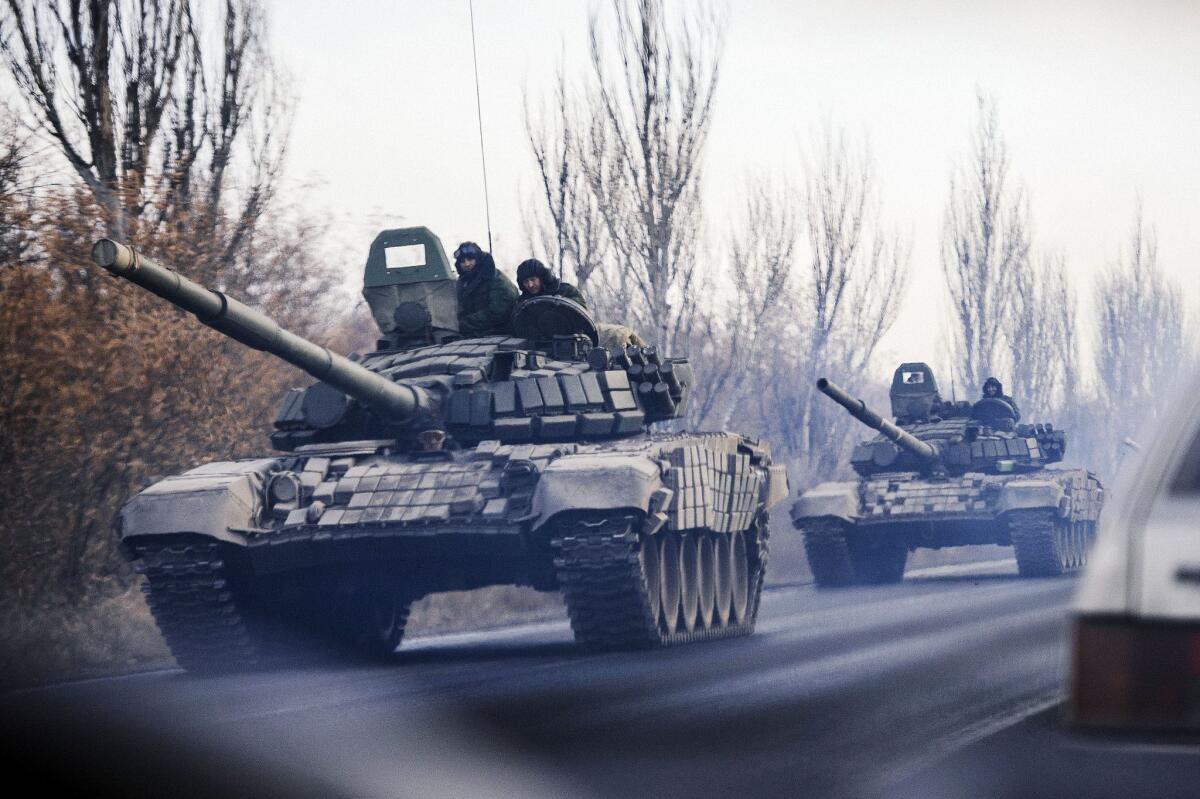Ukraine separatist leaders plot strategy with Russian lawmakers

- Share via
Leaders of the separatist regions of eastern Ukraine met with Russian lawmakers in Moscow on Monday to plot strategy for closer relations following elections earlier this month that they claim have empowered them to steer their territory out from under Ukrainian rule.
The purported government leaders from the Donetsk and Luhansk regions called for using the Russian ruble as currency for some transactions in their territory and pronounced a Sept. 5 cease-fire signed with the Ukrainian government all but dead.
The defiant moves by the two republics at a special session of Russia’s Federation Council, the upper house of parliament, reflected the separatists’ determination to wrest their territory out of Ukraine and align with the rebellion’s benefactors in Moscow. No nation has recognized the independence of the two regions.
“As of today, the Minsk agreements are not working. There is no mechanism that controls them and that implements them,” Andrei Purgin, deputy prime minister of the proclaimed Donetsk People’s Republic, told the Russian senators, referring to the battered cease-fire signed in the Belarus capital two months ago.
Purgin blamed the truce failure on Kiev. But his trip to consult with Russian leaders coincided with reports by European security monitors of at least two new convoys of Russian armaments and fighters moving through eastern Ukraine over the weekend.
The Organization for Security and Cooperation in Europe, which has more than 100 monitors deployed in Ukraine to keep watch on irregular military activity, reported Saturday that it had witnessed at least 43 tanks, trucks and troop transports headed west after crossing into separatist-held territory in eastern Ukraine. The Russian-made trucks were carrying howitzers and fighters in olive-drab uniforms without insignia, OSCE reported.
Russia’s RIA Novosti news agency quoted a separatist military commander for Donetsk, Eduard Basurin, as saying the arms convoys belonged to his forces.
Purgin also told the Russian lawmakers on the committee created to assist the separatist regions of eastern Ukraine that emergency response workers would begin removing the wreckage of Malaysia Airlines Flight 17 from around the village of Hrabove beginning Tuesday. Debris from the July 17 disaster was scattered across miles of farmland in the southern Donetsk region after the Boeing 777 flying from Amsterdam to Kuala Lumpur was brought down by a missile believed to have been fired from separatist-held territory. All 298 on board were killed.
Purgin said the crash site evidence would be removed by rail, likely through the neighboring Zaporizha region, but did not say where it would be sent.
It wasn’t clear whether the decision to collect the debris was made in conjunction with Dutch forensics investigators, who have been hampered in their attempts to probe the crash site by persistent fighting in the area.
Purgin was joined on the Moscow trip by Alexei Karyakin, chairman of the Luhansk People’s Republic’s newly elected Supreme Council. Karyakin told the Russian lawmakers that the leadership is still establishing independent governing bodies and will decide later whether to seek annexation to Russia, as happened with Ukraine’s Crimea region in March.
Both so-called people’s republics held elections for government leaders and legislature-like councils on Nov. 2, in defiance of U.N., U.S. and European warnings that the votes were illegal and likely to further destabilize the conflict areas of eastern Ukraine. The separatist leaders have called on other Ukrainian regions throughout the south and east to join them in an emerging new state of Novorossiya -- the czarist-era name for the Black Sea region conquered by Imperial Russia in the late 18th century.
Follow @cjwilliamslat for the latest international news 24/7
More to Read
Sign up for Essential California
The most important California stories and recommendations in your inbox every morning.
You may occasionally receive promotional content from the Los Angeles Times.














